Using hashtags effectively in your tweets can significantly enhance engagement and broaden your audience reach. With TweetGlide, you can access tailored hashtag suggestions and performance insights, allowing you to optimize your hashtag strategy. By focusing on relevance and moderation, you can ensure that your hashtags align with your content and resonate with your followers.

How can TweetGlide enhance hashtag usage in tweets?
TweetGlide enhances hashtag usage by providing tailored suggestions and performance insights, enabling users to optimize their tweets effectively. By leveraging these features, users can increase engagement and reach a broader audience through strategic hashtag implementation.
Streamlined hashtag suggestions
TweetGlide offers streamlined hashtag suggestions based on trending topics and user interests. This feature analyzes your tweet content and recommends relevant hashtags that can boost visibility and engagement.
For example, if your tweet discusses digital marketing, TweetGlide might suggest hashtags like #DigitalMarketing, #SEO, or #ContentStrategy. Using 2-3 well-chosen hashtags can significantly enhance your tweet’s discoverability.
Real-time hashtag performance analytics
With real-time hashtag performance analytics, TweetGlide allows users to track how well their hashtags are performing. This includes metrics such as engagement rates, impressions, and click-through rates, helping you understand which hashtags resonate with your audience.
By regularly reviewing these analytics, you can refine your hashtag strategy. For instance, if a specific hashtag consistently underperforms, consider replacing it with a more effective alternative to maximize your tweet’s impact.
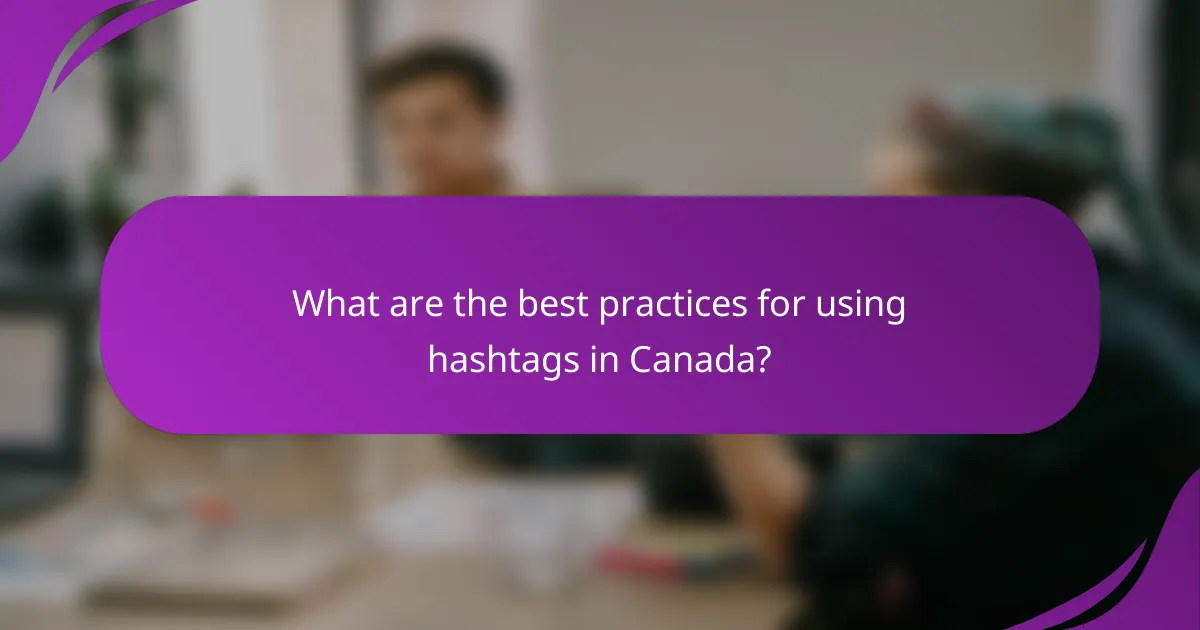
What are the best practices for using hashtags in Canada?
To use hashtags effectively in Canada, focus on relevance and moderation. Limit the number of hashtags to enhance engagement and ensure they align with your tweet’s content.
Limit hashtags to 1-3 per tweet
Using 1 to 3 hashtags per tweet is optimal for maintaining clarity and engagement. Tweets with too many hashtags can appear cluttered and may dilute your message.
For example, if you are tweeting about a local event in Toronto, using hashtags like #TorontoEvents and #CommunityEngagement can effectively target your audience without overwhelming them.
Use relevant and trending hashtags
Selecting relevant and trending hashtags increases the visibility of your tweets. Research current trends and incorporate hashtags that resonate with your audience’s interests.
Utilize tools like TweetGlide to identify trending hashtags in Canada. For instance, if a popular topic is #CanadianMusic, including this in your tweet about a local concert can attract more engagement.
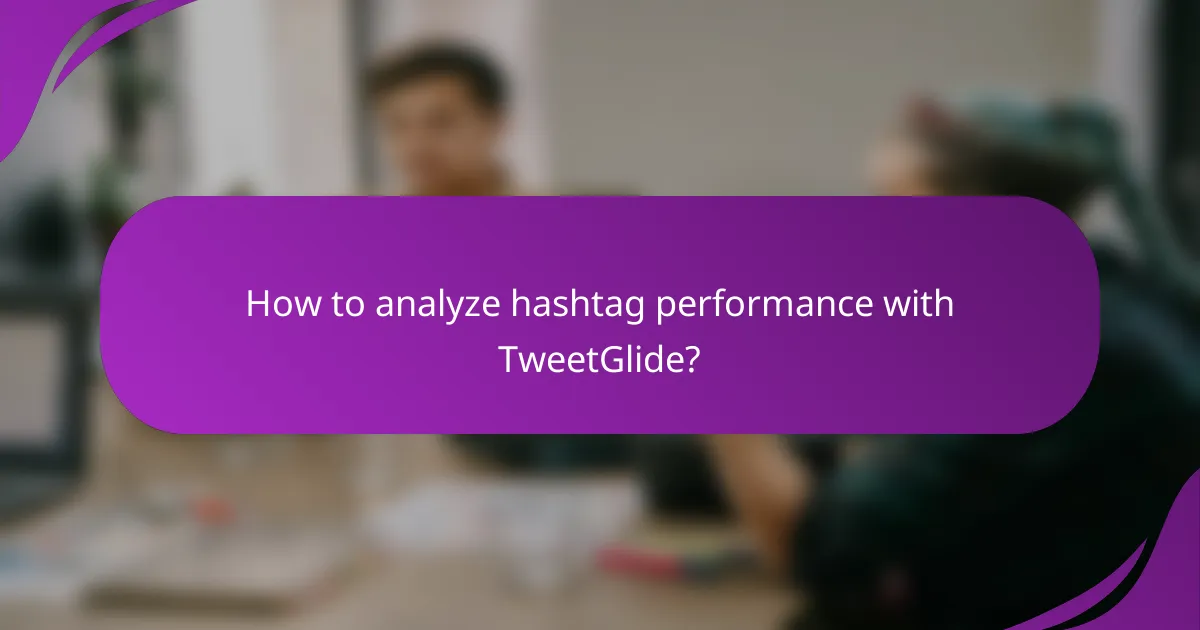
How to analyze hashtag performance with TweetGlide?
Analyzing hashtag performance with TweetGlide involves tracking engagement metrics and comparing effectiveness over time. This helps you understand which hashtags resonate with your audience and optimize your Twitter strategy accordingly.
Track engagement metrics
To effectively track engagement metrics, focus on key indicators such as likes, retweets, and replies associated with your hashtags. TweetGlide provides a dashboard that displays these metrics, allowing you to assess which hashtags drive the most interaction.
Regularly monitor these metrics to identify trends. For instance, if a particular hashtag consistently generates higher engagement, consider using it more frequently in your tweets. Conversely, if a hashtag underperforms, it may be time to replace it with a more relevant option.
Compare hashtag effectiveness over time
Comparing hashtag effectiveness over time is crucial for refining your Twitter strategy. Use TweetGlide’s historical data features to analyze how engagement changes with different hashtags across various campaigns or time periods.
Establish a baseline by tracking the performance of your hashtags over several weeks or months. Look for patterns, such as seasonal spikes in engagement or shifts in audience preferences. This analysis can guide your future hashtag choices and content planning.
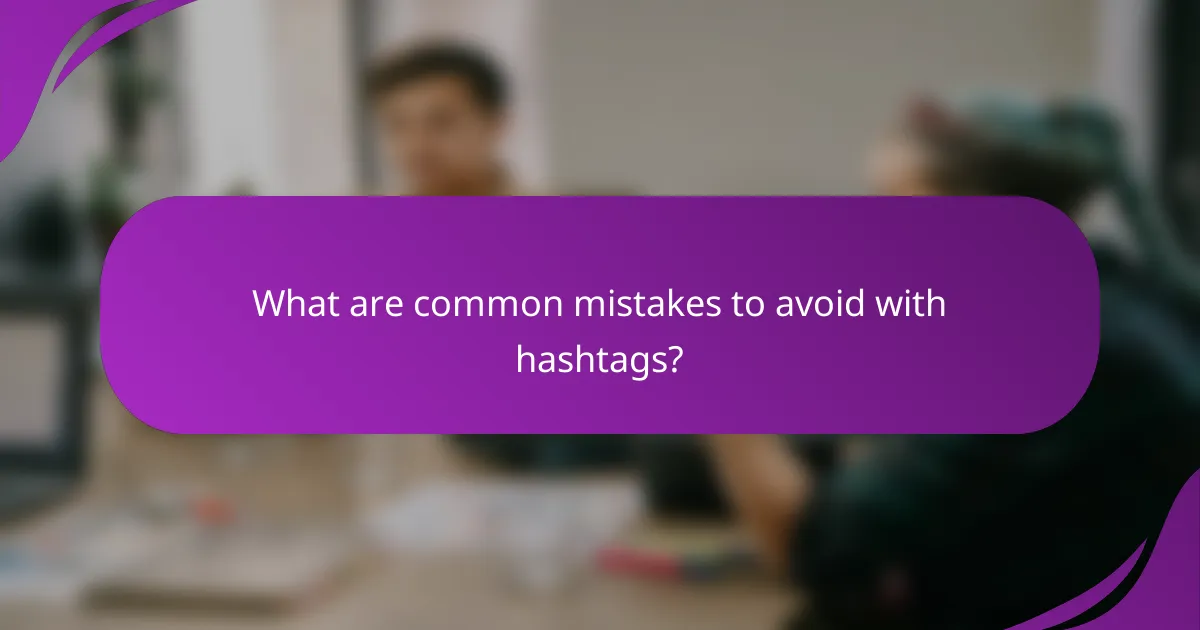
What are common mistakes to avoid with hashtags?
Common mistakes with hashtags include overloading tweets and using irrelevant tags. These errors can dilute your message and reduce engagement, making it crucial to use hashtags strategically.
Overloading tweets with hashtags
Using too many hashtags in a single tweet can overwhelm your audience and distract from your main message. A good rule of thumb is to limit yourself to one or two relevant hashtags per tweet to maintain clarity and focus.
For instance, tweets with one or two hashtags often see higher engagement rates compared to those with three or more. Aim for simplicity to ensure your audience grasps your content quickly.
Using irrelevant hashtags
Incorporating hashtags that are not directly related to your tweet can mislead your audience and damage your credibility. Always choose hashtags that accurately reflect the content of your tweet to attract the right followers.
For example, if your tweet discusses a new product, use hashtags related to that product or its category. Avoid trending hashtags that have no connection to your content, as this can frustrate users and lead to negative perceptions of your brand.
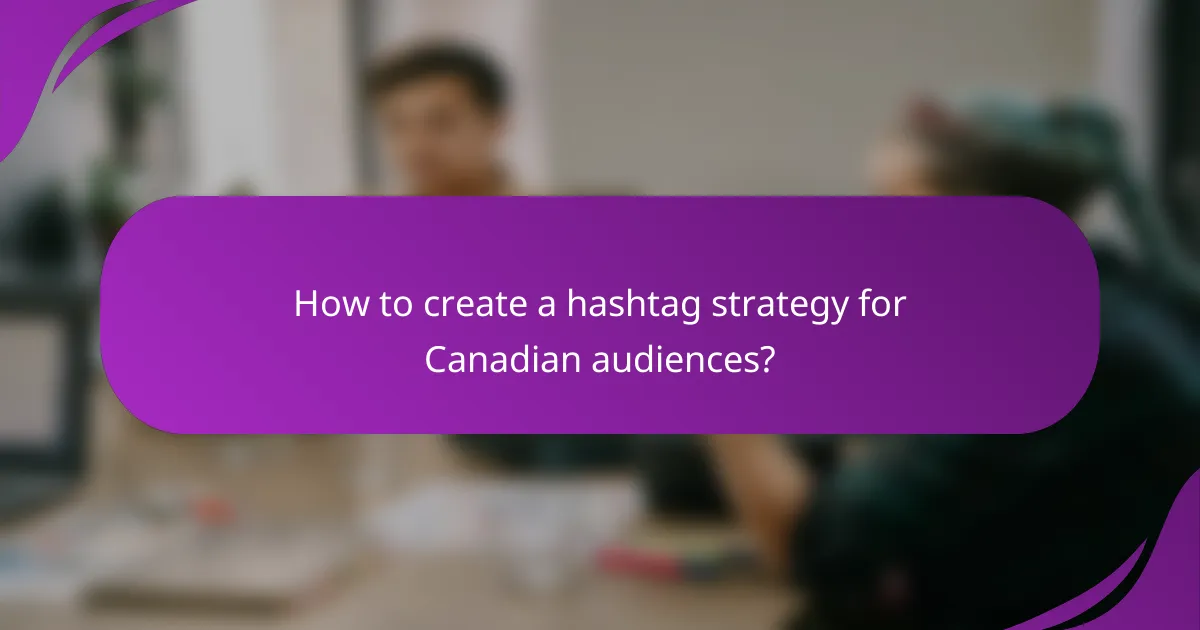
How to create a hashtag strategy for Canadian audiences?
To create an effective hashtag strategy for Canadian audiences, focus on local relevance and cultural nuances. Use hashtags that resonate with Canadian interests and trends to enhance engagement and visibility in your tweets.
Identify target audience interests
Understanding the interests of your target audience is crucial for effective hashtag use. Research popular topics within Canada, such as local events, cultural celebrations, or trending issues that matter to Canadians. Tailoring your hashtags to these interests can significantly improve your tweet’s reach.
Consider using tools like Twitter Analytics or social listening platforms to gather insights about what your audience is discussing. This data can guide you in selecting hashtags that align with their preferences and increase engagement.
Monitor competitor hashtag usage
Keeping an eye on how competitors use hashtags can provide valuable insights for your strategy. Analyze the hashtags they employ in successful tweets to identify patterns or popular tags within your niche. This can help you discover effective hashtags that resonate with your shared audience.
Additionally, consider creating a list of competitors and regularly checking their tweets. Look for recurring hashtags that generate high engagement, and experiment with incorporating similar tags into your own posts while ensuring they remain relevant to your content.
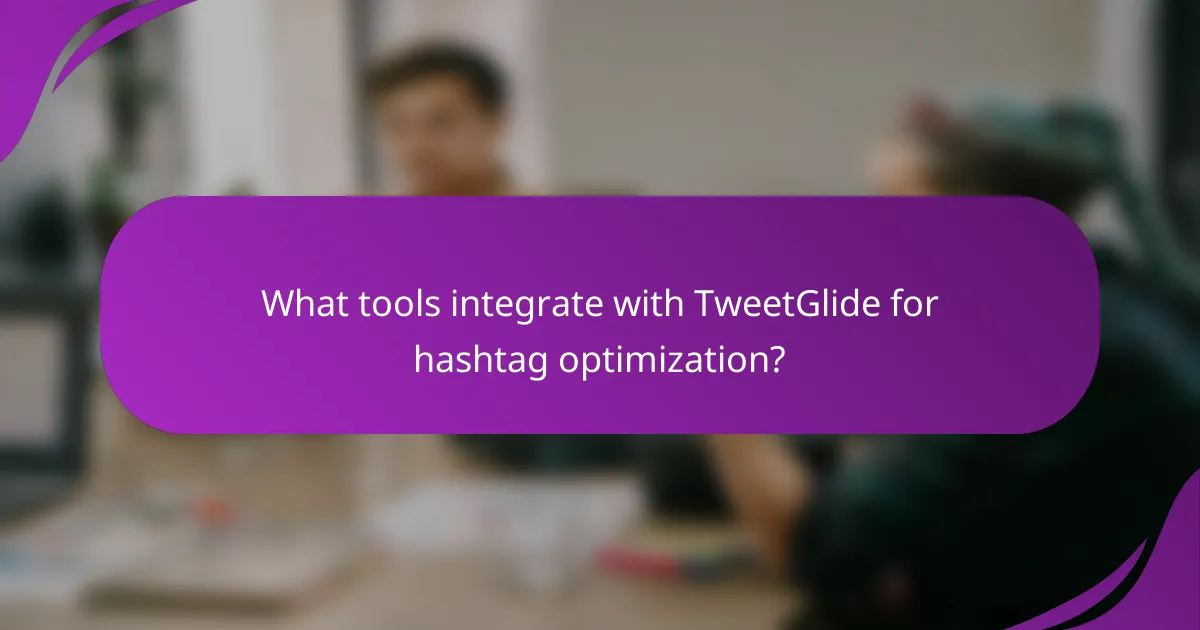
What tools integrate with TweetGlide for hashtag optimization?
TweetGlide integrates with several tools that enhance hashtag optimization, allowing users to maximize their reach and engagement on Twitter. Key integrations include Buffer for scheduling tweets and Canva for creating engaging hashtag graphics.
Buffer for scheduling tweets
Buffer is a powerful tool for scheduling tweets, enabling users to plan their posts in advance. By using Buffer, you can strategically time your tweets to coincide with peak engagement periods, ensuring your hashtags reach a larger audience.
When scheduling, consider using a mix of trending and niche hashtags to attract diverse followers. Aim to post during high-traffic times, typically early mornings or late afternoons, depending on your target audience’s habits.
Canva for hashtag graphics
Canva allows users to create visually appealing graphics that incorporate hashtags, making your tweets stand out. By designing eye-catching images, you can effectively draw attention to your hashtags and improve engagement rates.
To optimize your graphics, use bold fonts and contrasting colors to highlight your hashtags. Keep the design simple and ensure that the text is legible on mobile devices, as many users access Twitter through their phones.
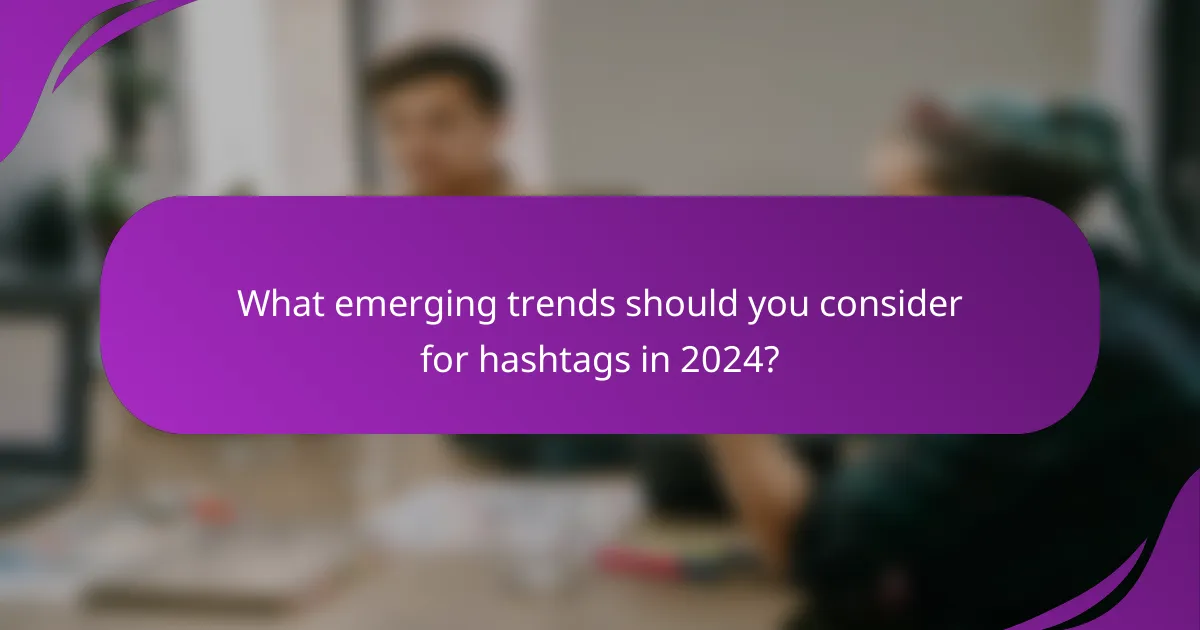
What emerging trends should you consider for hashtags in 2024?
In 2024, the effective use of hashtags will increasingly revolve around branded hashtags, the integration of trending topics, and the strategic use of fewer, more impactful tags. Understanding these trends can help you enhance visibility and engagement on Twitter.
Increased use of branded hashtags
Branded hashtags are becoming essential for businesses looking to create a unique identity on Twitter. These hashtags help in building brand recognition and fostering community engagement around specific campaigns or products.
To implement branded hashtags effectively, ensure they are concise, memorable, and relevant to your brand’s messaging. For example, a company launching a new product might use a hashtag like #NewGadgetLaunch to encourage user-generated content and discussions.
Avoid using overly complex or lengthy hashtags, as they can confuse users and reduce engagement. Aim for one or two branded hashtags per tweet to maintain clarity and focus.
